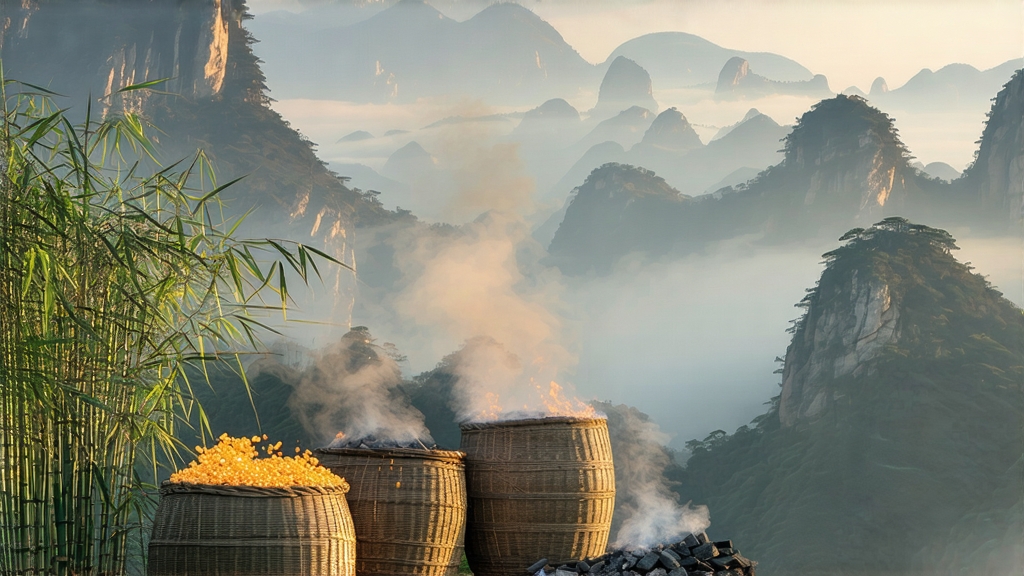
Tucked high in the mist-veiled Dabie Mountains of western Anhui Province, Huoshan Huangya has quietly captivated Chinese emperors, poets, and tea masters for more than seven centuries. Unlike its better-known green cousin Longjing or the rock-solid Wuyi oolongs, this “yellow bud” tea remains a well-kept secret even inside China, its tiny annual yield—barely 20 000 kg—absorbed by collectors before the leaves finish withering. To encounter Huoshan Huangya is to taste the moment when green tea is persuaded to pause, exhale, and turn golden.
History: from tribute to near extinction
The first written record appears in 1495, when the Ming Dynasty’s Imperial Household Department listed “Huoshan tribute buds” alongside leopard skins and Sichuan pepper. Legend claims that the Hongwu Emperor, tasting the tea in Nanjing, noted its cup looked like “liquid topaz” and decreed that every spring three bamboo tubes of the smallest buds be carried by relay riders 600 km to the capital. During the Qing, the tea’s bright yellow liquor matched the imperial palette so perfectly that court painters used it to tint dragon robes. Yet by the 1930s wars and banditry had reduced production to a few family plots; in 1972 the cultivar was considered extinct until a team of agronomists found three ancient bushes clinging to a cliff behind Zhaizi Temple. Cuttings were taken, grafted onto seed-stock rootings, and slowly coaxed back onto terraced gardens at 600–800 m elevation. The revival succeeded: in 2008 Huoshan Huangya became one of only two yellow teas protected under China’s National Geographic Indication law.
Terroir: why the mountain smells of orchids
The Dabie range acts as a climatic gatekeeper, trapping humid air from the Yangtze floodplain and releasing it as perpetual fog. Day-night temperature swings of 10–12 °C slow photosynthesis, stacking amino acids—especially L-theanine—into the buds. Soils are quartz-rich yellow granite loam, acidic (pH 4.8–5.2) and laced with manganese and zinc leached from Paleozoic schist. Native magnolia and wild orchids share the understory, their root exudates contributing a lactonic sweetness that later emerges in the tea’s finish as unmistakable “orchid milk” aroma.
Cultivar and picking calendar
Only one clone is legally entitled to the name: the Huoshan early-bud cultivar (Camellia sinensis var. sinensis ‘Huozao 1’). Picking begins when 5 % of the garden’s buds reach “sparrow’s tongue” length—12–15 mm—usually between 20 March and 5 April. Two strict rules govern the pluck: “no open leaf, no purple tip, no dew”. Pickers work from 05:30 to 09:00, placing buds in shallow bamboo sieves lined with mosquito-net silk to prevent compression. A skilled woman can gather 600 g fresh buds in a morning; it takes 55 000 buds—an entire day’s harvest for twenty pickers—to yield 1 kg of finished tea.
Craft: the secret menhuang “sealed yellowing”
Yellow tea’s identity rests on an extra step inserted between green tea’s kill-green and rolling stages. In Huoshan this is called menhuang, literally “closing the yellow”. Within 30 minutes of picking, buds are spread 2 cm thick on bamboo trays and wilted for 90 minutes at 28 °C until they lose 8 % moisture. They are then pan-fired in cast-iron woks at 160 °C for 3 minutes—just long enough to denature polyphenol oxidase without fixing the green colour. While still at 50 °C the buds are stacked in oak boxes, covered with wet linen, and left to suffocate for 4–6 hours. During this anaerobic interval chlorophyll breaks down into pheophytin, catechins dimerize into theaflavins, and a faint yellow pigment permeates the leaf. The process is repeated twice more with gradually lower temperatures and longer intervals, each cycle deepening the golden hue. Finally the leaves are hand-rolled into tight needles and given a low-temperature charcoal bake (45 °C, 40 minutes) over embers of local chestnut wood. The